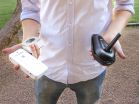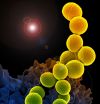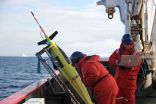(Press-News.org) ANN ARBOR--In a step toward robots smaller than a grain of sand, University of Michigan researchers have shown how chains of self-assembling particles could serve as electrically activated muscles in the tiny machines.
So-called microbots would be handy in many areas, particularly medicine and manufacturing. But several challenges lie between current technologies and science fiction possibilities. Two of the big ones are building the 'bots and making them mobile.
"We are inspired by ideas of microscopic robots," said Michael Solomon, a professor of chemical engineering. "They could work together and go places that have never been possible before."
Solomon and his group demonstrated that some gold plating and an alternating electric field can help oblong particles form chains that extend by roughly 36 percent when the electric field is on.
"What's really important in the field of nanotechnology right now is not just assembling into structures, but assembling into structures that can change or shape-shift," said Sharon Glotzer, the Stuart W. Churchill Professor of Chemical Engineering, whose team developed computer simulations that helped explain how the chains grew and operated.
The innovation that led to the shape-shifting, said Aayush Shah, a doctoral student in Solomon's group, is the addition of the electric field to control the behavior of the particles.
"The particles are like children in a playground," Shah said. "They do interesting things on their own, but it takes a headmaster to make them do interesting things together."
The team started with particles similar to those found in paint, with diameters of about a hundredth the width of a strand of hair. They stretched these particles into football shapes and coated one side of each football with gold. The gilded halves attracted one another in slightly salty water--ideally about half the salt concentration in the sports drink Powerade. The more salt in the water, the stronger the attraction.
Left to their own devices, the particles formed short chains of overlapping pairs, averaging around 50 or 60 particles to a chain. When exposed to an alternating electric field, the chains seemed to add new particles indefinitely. But the real excitement was in the way that the chains stretched.
"We want them to work like little muscles," Glotzer said. "You could imagine many of these fibers lining up with the field and producing locomotion by expanding and contracting."
While the force generated by the fibers is about 1,000 times weaker than human muscle tissue per unit area, it may be enough for microbots.
"If we can get the chains to swarm together, we can get them to lift loads, move around, do things that biological muscles do," Solomon said.
Minuscule, muscled robots may be many years away, but more immediately, the particles could enable electronics that rewire on demand.
"These chains are essentially wires, so you could assemble them into a circuit for reconfigurable electronics," said Solomon.
The team is still investigating how the phenomenon works.
"We don't fully understand why the chains extend, but we have some ideas," said Benjamin Schultz, a graduate student in Glotzer's group.
INFORMATION:
The study, appearing in the journal Nature Materials, is titled "Actuation of shape-memory colloidal fibres of Janus ellipsoids." The research was supported by the U.S. Army Research Office, the Assistant Secretary of Defense for Research and Engineering, and the U.S. Department of Defense.
Solomon is also a professor of macromolecular science and engineering. Glotzer is also a professor of materials science and engineering, macromolecular science and engineering, physics and applied physics.
Michael Solomon: http://bit.ly/1s9xk2b
Sharon Glotzer: http://bit.ly/1tgM2EH
BUFFALO, N.Y. - Most people rarely sing publicly outside of a duty-bound rendition of "Happy Birthday." And since that particular song is usually offered as a group performance, even the reluctant join in the spirit of the occasion, hoping their individual shortcomings will be cloaked by the chorus.
"I can't sing," says the hesitant performer. But a University at Buffalo psychologist believes that most people are not as bad at singing as they might think and he is collaborating on the development of an online test that will evaluate participants' ability to match specific ...
Boulder, Colo. -- Nov. 10, 2014 -- When the double asteroid Patroclus-Menoetius passed directly in front of a star on the night of Oct. 20, a team of volunteer astronomers across the U.S. was waiting.
Observing the event, known as an occultation, from multiple sites where each observer recorded the precise time the star was obscured, yielded the first accurate determination of the two objects' size and shape. The analysis was led by Dr. Marc W. Buie, staff scientist in Southwest Research Institute's (SwRI) Space Studies Department in Boulder, Colo.
The team effort was ...
Scientists at the University of Arizona have discovered what might be the closest thing to "baby photos" of our solar system. A young star called HD 95086 is found to have two dust belts, analogous to the asteroid and Kuiper belts in the Solar System, surrounded by a large dust halo that only young planetary systems have.
Similar dust structures are also found around another, slightly older star called HR 8799, where four massive planets occupy the large gap between the two belts. HR 8799, the first star found to host four directly imaged planets, is often referred ...
A new class of apps and wireless devices used by private pilots during flights for everything from GPS information to data about nearby aircraft is vulnerable to a wide range of security attacks, which in some scenarios could lead to catastrophic outcomes, according to computer scientists at the University of California, San Diego and Johns Hopkins University. They presented their findings Nov. 5 at the 21st ACM Conference on Computer and Communications Security in Scottsdale, Ariz.
`
Researchers examined three combinations of devices and apps most commonly used by private ...
Regulation of a single, specific gene in a brain region related to drug addiction and depression is sufficient to reduce drug and stress responses, according to a study conducted at the Icahn School of Medicine at Mount Sinai and published October 27 online in the journal Nature Neuroscience.
The Mount Sinai study focuses on epigenetics, the study of changes in the action of human genes caused, not by changes in DNA code we inherit from our parents, but instead by molecules that regulate when, where and to what degree our genetic material is activated.
Previous research ...
System 05B degenerated into a remnant low pressure area on Nov. 8 and lingered near the east-central coast of India for two days before dissipating on Nov. 10.
The tropical cyclone's western edge spread over land on Sunday, Nov. 9 while the center of the low-level circulation remained over open waters of the Bay of Bengal. On that day, 05B's remnants were centered near 14.0 north latitude and 83.8 east longitude, about 215 miles east-northeast of Chennai, India.
Infrared imagery from satellites on Nov. 9 indicated that the low-level circulation center of the storm was ...
URBANA, Ill. - Dating couples who have moved toward marriage over the course of their relationship remember accurately what was going on at each stage of their deepening commitment. But couples whose commitment to each other has stagnated or regressed are far less accurate in their memories of their relationships, says a new University of Illinois study.
"People like to feel that they're making progress as a couple. If they're not--if, in fact, the relationship is in trouble--they may have distorted recollections that help them feel like they're moving forward because ...
PORTLAND, Ore. - Use of "antibiograms" in skilled nursing facilities could improve antibiotic effectiveness and help address problems with antibiotic resistance that are becoming a national crisis, researchers conclude in a new study.
Antibiograms are tools that aid health care practitioners in prescribing antibiotics in local populations, such as a hospital, nursing home or the community. They are based on information from microbiology laboratory tests and provide information on how likely a certain antibiotic is to effectively treat a particular infection.
The recent ...
Alexandria, Va. -- On March 13, 1989, a geomagnetic storm spawned by a solar outburst struck Earth, triggering instabilities in the electric-power grid that serves much of eastern Canada and the U.S. The storm led to blackouts for more than 6 million customers and caused tens of millions of dollars in damages and economic losses. More than 25 years later, the possibility of another such catastrophe still looms, and the day-to-day effects of space weather on electrical systems remain difficult to quantify. Now, a new study correlating electrical insurance claims with geomagnetic ...
The rapidly melting ice sheets on the coast of West Antarctica are a potential major contributor to rising ocean levels worldwide. Although warm water near the coast is thought to be the main factor causing the ice to melt, the process by which this water ends up near the cold continent is not well understood.
Using robotic ocean gliders, Caltech researchers have now found that swirling ocean eddies, similar to atmospheric storms, play an important role in transporting these warm waters to the Antarctic coast--a discovery that will help the scientific community determine ...




